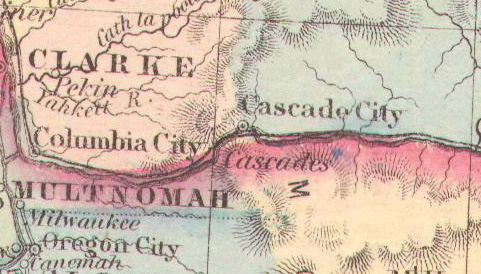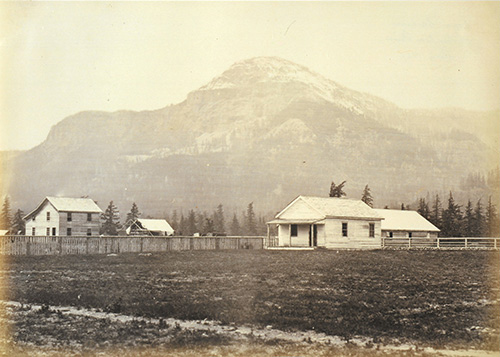
Recently I was studying an 1859 map of the Washington Territory when I came across a town name I didn’t recognize. It was just east of Vancouver in Skamania County, and it was called Cascade City. At first, I thought it might be Stevenson but when I overlayed a newer map over the older one, Stevenson was farther to the east. No matter how good my Googling skills are, I still couldn’t find anything about Cascade City, Washington. The history nerd in me needed to find out what caused the disappearance of this once thriving town. What do I do when I can’t find any reference of something that’s nearly 175 years old? I search newspaper archives. More specifically, for local history I search the Oregonian’s archives.
The Cascade Rapids
The Cascade Rapids on the Columbia River was the last dangerous obstacle for weary settlers migrating westward along the Oregon Trail. The stretch along the Columbia River was 6 miles of impassible white-water rapids and foaming whirlpools and was located approximately between what is now the Bonneville Dam and Stevenson, Washington. Sternwheelers, steamers and other boats couldn’t traverse the dangerous rapids. They would have to unload their goods before the rapids then portage around the rapids. Once past the rapids they would then load their goods back on to a boat and continue with their journey.
An Outpost for Travelers

Entrepreneurs of the time saw the Cascade Rapids as a business opportunity and founded the area as an outpost for travelers. After the Donation Land Act of 1850 was passed, George. W. Johnson filed the first Donation Land Claim in the Cascade Rapids area for 320 acres. He then had his claim platted as the town of Cascades, Washington Territory. Cascades was only the third town north of the Columbia River to be platted. Johnson and other settlers to the area built a trading store, a bakery and a public house for travelers. Cascades City continued to grow and prosper.
In 1858, Thomas and Ellen McNatt opened a hotel and tavern on the main entrance road into the fort. They also operated a barn and stable to board travelers’ horses. You can see the gravestone of Thomas McNatt towards the end of the interpretive trail.
Then in 1863 a railroad, known as the Cascades Portage Railroad, was built along the portage road to speed up the transfer of goods. The railway spanned the entire 6-mile length of the portage road from the Lower Landing on Hamilton Island to the Upper Landing where Stevenson, Washington is now. By 1894, the Cascades Portage Railroad was obsolete and shut down.
Subscribe to my blog for new articles and a chance to win an authentic, antique map!
Clashes with Native Americans

With more settlers migrating into the Oregon and Washington Territories, clashes with Native Americans around the Cascade Rapids increased. Before the settlers arrived, the Cascade Rapids was an important salmon fishery for the Native Americans from which they gathered most of their food for the year. With the combination of the epidemics of the early 1800s and unfavorable terms in the Willamette Valley Treaty of 1855, the Native Americans were forced from their native lands. The Native Americans were angry and an uprising was inevitable.
Native Americans were raiding travelers along the portage road, making their journey much more dangerous. The Federal Government took notice of the attacks by Native Americans around the rapids. In 1855, the U.S. Army seized some land from George Johnson’s Donation Land claim and immediately began building a fort to protect the portage road from attacks by Native Americans.
Cascades Massacre
Early in the morning on March 26, 1856, before the fort was completely built, warriors from the Yakama, Klickitat and Cascades tribes joined forces and attacked the white soldiers and settlers around the Cascade Rapids. This is what was called the Cascades Massacre. Angry from being kicked off their lands and moved to reservations, the Native American warriors killed three soldiers and 14 civilians. The next day the U.S. government sent reinforcements.
Forty mounted soldiers led by Lieutenant Phil Sheridan arrived on a steamer ship from Fort Vancouver and successfully repelled the Native American attackers. Warriors from the Yakima Tribe retreated leaving behind the Cascades who quickly surrendered. The U.S. Army quickly, and illegally, tried nine Cascades with treason. They were found guilty and each one was hung and shot.
The Army immediately began building a blockhouse to replace the burned down fort. By late 1856, the Army had finished building the blockhouse and had secured the 6-mile portage route around the rapids.
The First County Seat
When Skamania County was founded in 1854, the first county seat was Cascades City. The former quartermaster’s house of Fort Cascades acted as the county government office until it was relocated to the fort hospital within the fort itself. Cascades City remained the county seat of Skamania County for almost 40 years. Then late one night in 1893, after a disagreement over rental fees, a group of men broke into the county government office at Cascades City and surreptitiously moved the county records to Stevenson. Stevenson became the county seat overnight.
In 1861, the soldiers at Fort Cascades abandoned the fort and headed to fight in the Civil War. The townspeople took over the fort and the buildings left behind by the soldiers, converting the Quartermaster’s residence into a schoolhouse.
The Great Flood of 1894
Then, in the summer of 1894, the unimaginable happened. After sustained, heavy rainfall and a spring snowmelt, the Columbia River rose to an elevation of 39.7 feet causing significant flooding along the river. This was known as the Great Flood of 1894. As for Cascades City and Fort Cascades, the flood was catastrophic. When the flooding receded, the town and fort had been washed away. The power of the Columbia River had scoured away the soil beneath the town and fort exposing the rocks and boulders. Everything was washed away down river leaving just the heaviest of equipment behind that was either above the floodline or too heavy for the Columbia to wash away. The town of Cascades was never rebuilt and vanished into history forever.
What’s In a Name
It’s interesting to note that Cascade City has been called many different names. It was originally platted as the town of Cascades but, depending on what account you read, has also been called Lower Cascades and Cascade City. Newspapers from the time frequently advertised the location of post offices in the Washington Territory. In these advertisements, the town was called Cascade City. These days if I have to verify an address, I use the U.S. Post Office, so I am sticking with Cascade City as the official name of the town that vanished forever.
Fort Cascades National Historic Site
If you would like to explore what was once Cascade City and Fort Cascades, be sure to visit the Fort Cascades National Historic Site. Here you can walk along a 1.5-mile interpretive trail loop exploring the remnants of what was once the thriving town of Cascades and Fort Cascades along the Columbia River.
Driving Directions to the Fort Cascades National Historic Site
From Vancouver, take SR-14 East until just before the Bonneville Dam
Turn right on Dam Access Road
Follow the road west to the trailhead
From Portland, take I-205 north into Washington State
Once over the Glenn Jackson Bridge, take the first exit for SR-14 heading east
Turn right on Dam Access Road
Follow the road west to the trailhead

Thank you for this article !! VERY informative. I love our local history. My genealogy of my Great grandfather states in many sources his birth as Cascade(s) WA. For a couple years I assumed (!) it was Cascade Locks in OR. This article confirms Cascades as a legit place & the original sources of his birth in the 1880’s in WA were actually correct. This info would be great on Wikipedia.